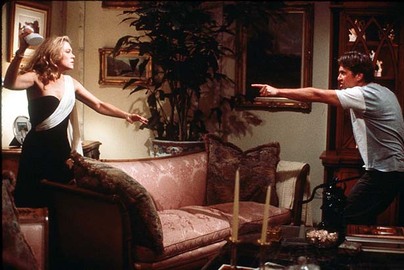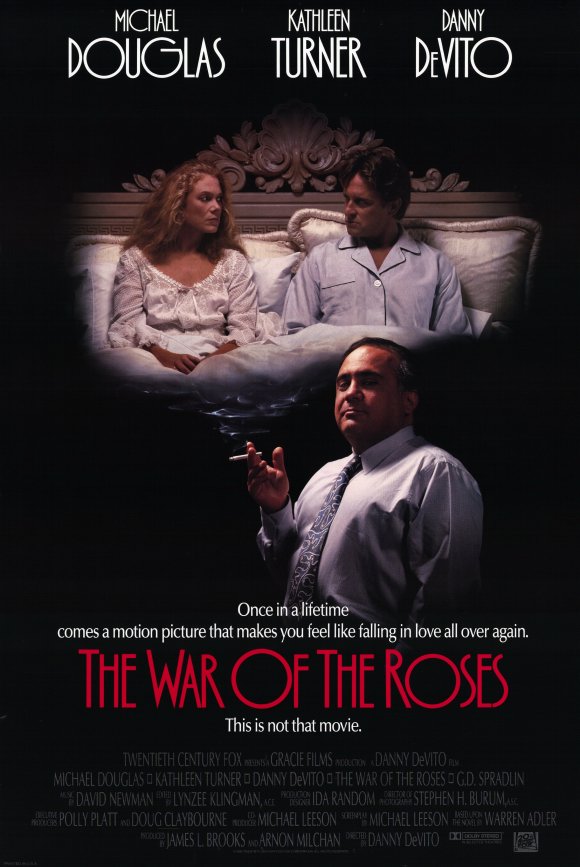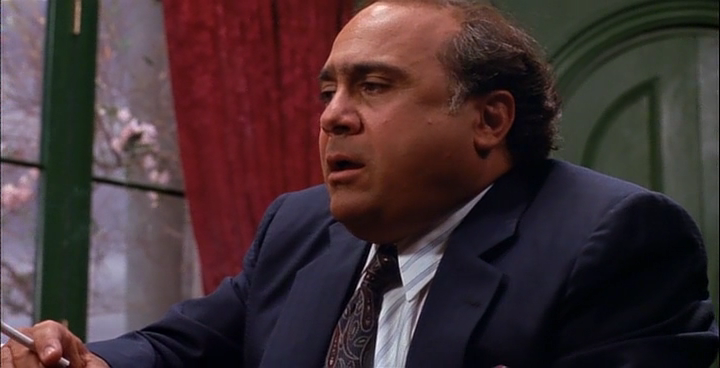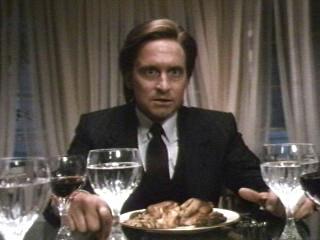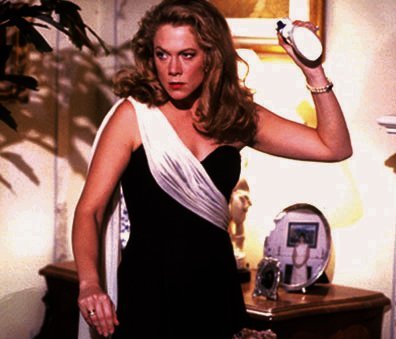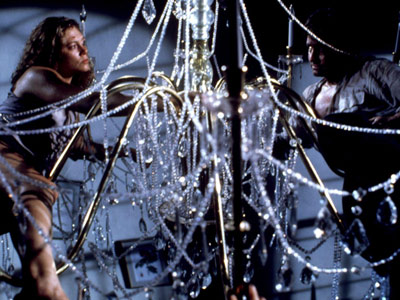From the Chicago Reader (December 15, 1989). — J.R.
THE WAR OF THE ROSES
*** (A must-see)
Directed by Danny DeVito
Written by Michael Leeson
With Michael Douglas, Kathleen Turner, DeVito, Marianne Sagebrecht, Sean Astin, and Heather Fairfield.
The proper tone for Danny DeVito’s second feature is set by a very short Matt Groening cartoon that precedes every print. A brief cadenza on familial hatred and violence is played out in a therapist’s office, where most of the hatred and violence is directed at the therapist, uniting the family in the process. The War of the Roses opens with another sort of therapist — Danny DeVito as high-priced lawyer Gavin D’Amato — talking to a client in his office. The landscape outside D’Amato’s office looks unusually fake, and DeVito’s delivery seems as self-consciously overarticulated as some of Woody Allen’s recent performances — to mix a metaphor, one can almost see the chalk marks in his verbal punctuation — but both of these oddities actually serve the story he is about to tell about a marriage and its demise.
Unlike the therapist in the Groening cartoon, D’Amato stands mostly outside the story he is telling, and he clearly represents the voice of reason rather than part of the problem. He obviously belongs to the same upper economic bracket as his friends Oliver and Barbara Rose (Michael Douglas and Kathleen Turner), the protagonists in this black comedy, since he informs his client at the outset, “I think you should hear this story through. It might matter to you. I won’t start the clock yet. My fee is $450 an hour, and when a man who makes $450 wants to tell you something for free, you should listen.” Although it may take a while to realize it, this act of generosity automatically places D’Amato in a moral category not shared by either of his friends; so it stands to reason that both the physical universe and the behavioral mode of this character should be set apart, didactically as well as stylistically, from the world of the Roses.
At the outset, at least, the world of the Roses is a familiar one, especially in movies. Roughly speaking, it is the utopian image of upper-crust life bequeathed to us by the Reagan era: a good life consisting of acquisitions and possessions — blessings that have to be counted and even inventoried in order to be appreciated. If one can speak in a language of objects, this is evidently the only language that Oliver and Barbara Rose know how to speak.
Significantly, they meet at an estate auction on Nantucket, the last day of the 1956 summer season, where they find themselves bidding against each other for an ivory figurine; she bids highest, and he informs her afterward that she’s gotten a real bargain. “Well, I guess I’ve got a good eye,” she says. (They’re both about to go away to college on scholarships — he as a law student, she as a gymnast — but they’re already pretty acquisitive. Later on, the same values are clearly in place when he becomes a successful lawyer and she sets about acquiring and decorating a mansion for them.) Although a full explanation of the figurine was cut from the film prior to release, it’s worth noting here. It’s an 18th-century Chinese medical homunculus of a nude woman, used by Chinese doctors who in that period were not allowed to look at naked female patients and used figurines to figure out how women “work.”
The figurine is a good symbol for the Rose marriage, because Oliver certainly doesn’t understand how his wife works, and both of them fixate on possessions, a trait that seems unconsciously designed to make up for this lack. (Another symbol for the marriage and its subsequent failure figures discreetly behind the opening credits — some fabric that gradually evolves into a suggestion of bed sheets, which hints at the marriage bed as a dunelike landscape, and eventually becomes, in the opening shot, a handkerchief into which D’Amato is blowing his nose.) There’s nothing preachy about the film — Oliver and Barbara are too recognizable and “normal” to come across as figures of satire in any ordinary sense. But the degree to which the possessions of this couple become their only means of communicating with one another — as gifts, as self-definitions, as bargaining chips, as points of contention, and ultimately as weapons — helps to explain why their escalating battles against one another, once Barbara decides that she wants a divorce, have a precise logic to them as expressions of their basic identities.
The movie’s audacity operates on at least three interlocking and interrelated levels: as a Christmas release, as a commentary on the star personas of Douglas and Turner, and as an account of a contemporary battle of the sexes, with particular relevance to feminism. In most other respects, the movie conforms rigorously to current notions of what defines a big Hollywood picture: big stars, expensive sets, a clearly defined trajectory of escalating action, conflict, and apocalyptic violence, and a climactic suspense set piece that wraps everything up into a coherent package pointing to an explicitly delivered moral.
As a Christmas release, the film bears witness to a rather disturbing national statistic that most Hollywood Christmas releases go out of their way to overlook or contradict: the huge number of violent crimes that take place in this country during the Christmas season and between family members. It’s an integral part of movie mythology that this end-of-the-year holiday be set up as a time of moral reckoning; consider A Christmas Carol, It’s a Wonderful Life, and all their variants. But families are generally posited as islands of security and comfort within this framework rather than linked directly to the zones of conflict and combat. Three pivotal sequences in The War of the Roses are set during Christmas seasons, and while the first and last of these take place in atmospheres of relative benevolence and generosity, the one in between, which receives the most attention in the film, is full of murderous feelings and mounting violence.
It’s also worth pointing out that this movie — set principally in a Washington, D.C., suburb — views this phenomenon in a specifically American context; a shot at a pivotal juncture near the end of the film shows the Capitol building in Washington through the window of D’Amato’s office, and it might not be accidental that an earlier view from this window frames a low-flying helicopter, which may remind us briefly of Vietnam. (If memory serves, this latter shot occurs shortly after Barbara demolishes Oliver’s foreign sports car with her catering van, which she maneuvers like a tank — a scene with distinct military overtones.)
As a commentary on the star personas of Douglas and Turner, the movie is obviously setting itself up in contrast to the romantic adventure mythology set up in Romancing the Stone and its sequel The Jewel of the Nile (both of which featured DeVito as well as Douglas and Turner), at the same time it’s working off of certain associations with each star from other films. The most pertinent associations with Douglas are his roles as a yuppie careerist in both Fatal Attraction and Wall Street — a character who is meant to be sympathetic in the former and a charismatic scoundrel and antihero in the latter, but who exhibits in both films a similar drive toward power and success through money.
In Fatal Attraction, the fruits of this drive are represented by a domestic haven in the suburbs; in Wall Street, they are more generally shown as money for its own sake, represented by the motto “Greed is good.” (In the current Film Comment, Gregg Kilday comments on Douglas’s Oscar-winning performance in Wall Street as follows: “For the Motion Picture Academy, which generally tries to counter the film industry’s own money-grubbing reputation by focusing the limelight on such paragons of moral virtue as Ben Kingsley’s Gandhi or Dustin Hoffman’s Rain Man, it was a rare tip of the hat to the new economic realities: rapacious acquisitiveness dressed up in the sheep’s clothing of deregulation, as brought to you by the corporate pirates of the Reagan era.”) In The War of the Roses, where Douglas plays neither a hero nor an antihero in the same sense, the success and acquisitiveness are more or less the same, but the world outside the home is implied rather than depicted, and the domestic behavior of his character is brought to the fore.
The associations we make with previous roles of Turner, on the other hand, are split into two categories: estranged housewives (in Peggy Sue Got Married and The Accidental Tourist) and deadly femmes fatales (in Body Heat and Prizzi’s Honor). While these two types might seem incompatible, Turner’s capacity to combine them in the same character in The War of the Roses has a lot to do with what gives this movie its edge.
As an oppressed and neglected housewife with a slow fuse, Barbara Rose emerges as a deadly avenger only gradually, but the transformation is a logical one. What mainly gives it its spin is the character’s purity of will and her strength once she reaches the boiling point — in contrast to her wimpier prevaricating husband. (A similar if somewhat simpler expression of this character development and sexual division can be found in the current She-Devil, a straight feminist revenge fantasy, where the growing strength and clearness of purpose of Roseanne Barr’s character in relation to her own yuppie husband, played by Ed Begley Jr., is equally pronounced — a sign of some progress in Hollywood depictions of women.)
Given the sexual biases that already exist in our culture, it’s not surprising that many members of the audience, female as well as male, seem to identify more easily with Oliver than with Barbara — judging from the reactions of a recent Friday-night crowd at Webster Place. She certainly tends to be the crueler of the two once their conflict is forced out into the open, and the unvarying quality of her hatred for her spouse is thrown into relief by Oliver’s periodic and futile efforts at reconciliation, as well as his increasing tendency to appear demented rather than simply angry. But Barbara’s anger and implacable will bring her position closer than Oliver’s to that of the macho existential hero; in the final analysis, it is she and not Douglas who is cast in the Dirty Harry part — the steely antagonist who gives no quarter.
Barbara never spells out her precise reasons for wanting a divorce, apart from the fact that she loathes her husband, which has led some critics to complain that the breakup of the marriage is insufficiently motivated. It’s true that the movie lacks the sort of facile psychologizing that compromises most American “problem” pictures — the 50s liberal impulse that characteristically gropes after easy explanations. But a closer look reveals that, in spite of the relative lack of psychologizing, the reason for Barbara’s hatred of Oliver — his utter self-absorption — is clearly laid out in the early years of their courtship and marriage. Like an extended version of the famous breakfast montage sequence in Citizen Kane, this part of the film aims at being suggestive rather than exhaustive, and nearly all of the details are telling — even when Oliver’s daughter playfully hides the papers he’s working on next to the Christmas tree. (The most succinct of these early episodes, and the best-acted sequence in the movie, has Oliver urging his wife to tell an anecdote about the purchase of their wineglasses at a dinner for his business partners, and then coaching and correcting her as she reluctantly proceeds.)
I don’t mean to suggest that this movie’s audacity is completely uncompromised. For one thing, in the war of the Roses the family dog is a cherished household possession that’s illogically spared (apparently because certain test-market audiences couldn’t bear to deal with the alternative); and a couple of sentimental scenes between father and son and between mother and daughter — before the two children leave for college and are conveniently excluded from the finale — beg the question, which is raised elsewhere, of whether or not these noncharacters are merely two more cherished household possessions.
But subtly interlaced through the movie as a whole is a satirical commentary on Oliver and Barbara’s preoccupation with objects to the exclusion of everything else, an omnipresent theme that makes the film more than just a dark comedy about marital discord. For starters, the story evolves within a claustrophobically sealed world of high-priced objects — in fact, as a friend has pointed out, many of the unorthodox camera movements and angles in DeVito’s eclectic and at times excessive mise en scene can be justified by the extent to which they expose still more of this bric-a-brac enclosing the characters. But it is also significant that the film’s few forays outside the Rose mansion reveal related satirical ideas about the power of money and objects in the world outside. When Oliver, after suffering what he believes is a heart attack, finds himself in a hospital emergency ward, the subsequent gags involve (1) a black man on an adjacent stretcher who reports that his wife stabbed him “this time” with a nail file (“She’s studying to be a manicurist”); (2) this wife angrily pointing out, after the doctor’s arrival, that she and her husband were there ahead of Oliver, though Oliver gets the doctor’s attention; and (3) the doctor’s concern about losing his pen when he wants Oliver to sign a form. In another scene set in D’Amato’s fancy and well-appointed office, we see D’Amato, who is representing Oliver in the divorce, come up with a law “that was put on the books for poor people” that enables Oliver to move back into the mansion being occupied by Barbara; later, in the same office, Barbara offers herself as a sex object to D’Amato in return for his getting Oliver to leave the house.
Although the story’s framing device and D’Amato himself provide the audience with some distance from the couple, there’s no question that the expensive objects on display (including Turner and Douglas themselves) are there for the audience’s delectation as well as the characters’, just as the eventual smashing of these objects provides a cautionary message for characters and audience alike. Like other Hollywood pictures, the movie deliberately leaves itself open to different levels of interpretation and identification, and can’t be said to offer its ideological critique overtly and without ambiguity. But compared with other recent efforts of DeVito, Douglas, and Turner, as well as other recent Christmas messages, it certainly offers a tonic with a built-in kicker.

